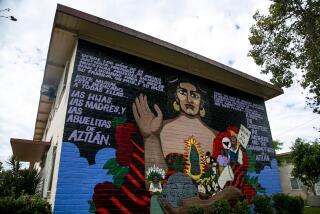‘Zoot Suit’: How Latino theater born in the farm fields changed L.A. theater forever
- Share via
It was 1946. The cotton-picking season was over in the San Joaquin Valley, but the truck wouldn’t go, the money was running out and this farmworker family was living on fish tacos. Father fished, mother made tortillas. When 6-year-old Luis fell into the river while fishing with his dad, Mama decided the boy would be safer in school.
So Luis climbed onto the big yellow bus with his fish taco lunch in a paper bag that his mother told him to bring back. One day, he couldn’t find the bag. He panicked.
“My teacher asked what was wrong,” recalled Luis Valdez, author and director of the “Zoot Suit” revival that’s in previews now and officially opens Feb. 12 at the Mark Taper Forum. “I mentioned the bag. She said, ‘Oh, I took it.’” The teacher walked Luis into a room where the bag was wet in a basin. She cut the paper into strips and placed them onto a mold — a monkey mask for the Christmas play.
Luis had been introduced to what he later called “one of the secrets of the universe”: papier-mâché. He was one of two first-graders chosen to wear those masks. It was his big moment.
Three days before the play, however, he came home to find the family packing. “We’re leaving,” his mother said. “We’re being evicted.”
Luis cried. His mother cried. And at dawn, the family climbed into a truck, and Luis watched his school recede into the valley fog.
It was a heartbreak that changed his life. “I took the secret of papier-mâché, the undying desire to do theater — and the residual anger of that eviction from the labor camp,” Valdez said in a recent conversation at the Music Center. “I was in that school 30 days. In and out. Twenty years later I met César Chavez and pitched him the idea of a farmworkers’ theater.”
Today, at a vigorous 76, hair and mustache graying, Valdez flashes the same benevolent smile he flashed when his aptly named El Teatro Campesino, the Farmworkers’ Theater, was in its infancy in the 1960s. Valdez and I first met during those salad days, shortly before I joined the drama desk of the Los Angeles Times, as I was completing my MFA on the Inner City Cultural Center, an L.A. company founded in response to the 1965 Watts Riots and the place where Valdez’s troupe of campesinos was invited to perform.
In September 1965, Chavez led a strike in the Central Valley to protest low pay and poor working conditions.
“I went to Delano to see Chavez in the first week of the strike,” Valdez said. “We marched, but I felt intimidated. Chavez had important meetings. I was afraid he’d see my idea as frivolous.”
Later, in San Francisco, he shared his thoughts with civil rights activist Dolores Huerta, co-founder of the farmworkers movement. She arranged a meeting between Valdez and Chavez, who was tired but supportive. “There’s no money for theater in Delano,” Chavez said. “No actors, no stage. Not even time to rehearse. You still want to do it?’”
Valdez’s reply: “Absolutely.”
Chavez was right about no money and no time. The workers were on the picket line, singing songs. It was raucous. Valdez threw placards around the necks of the campesinos, identified characters they could play and created his Teatro — whose corrosively funny one-acts that would become his trademark — out of instinct and thin air.
DEMIAN BICHIR: Interview with the star of the “Zoot Suit” revival »
What was striking about that early work was its combustion of raw energy, defiance, irony and joy. Intended to increase awareness of the Delano strike — la huelga — the plays used comedy to humanize the plight of laborers by spoofing the callous treatment they received at the hands of grape growers. No one had spoken up so fearlessly before — not for the strike, the farmworkers nor the Latino presence in California.
It was new. And it was important. El Teatro took its cue from the San Francisco Mime Troupe, a ramshackle Vietnam-era political protest group that played parks and public places with abandon and glee. Valdez had cut his acting teeth as a member of that troupe. But he really wanted to be a playwright — a bilingual, bicultural American playwright born to bilingual farmworkers in Delano.
I traveled to Delano, saw El Teatro perform in the fields and chatted with Valdez — relaxed, chomping on his cigar, eager to discuss the future. That included moving on to full-length plays. I asked what he’d do for money. Sell a couple of cars, he said. Money didn’t matter. Schedules didn’t either. Visiting critics? Ha!
“We were from the grape strike,” Valdez said, laughing these many years later. “We were farmworkers. We hadn’t reached PR!”
But El Teatro Campesino was the real deal.
“That’s what Peter Brook said when he came to work with us in 1973 — ‘Your theater is organic,’” Valdez said, quoting the eminent English director and two-time Tony winner.
Valdez’s first full-length play, “The Shrunken Head of Pancho Villa,” was performed in 1965 and won the attention of William Saroyan. (“Saroyan was from Fresno, man,” Valdez said. “I could identify!”) Ten years later Valdez landed on the radar of L.A.’s most significant theater-maker, Gordon Davidson, artistic director of Center Theatre Group, who commissioned a full-length play.
That play was “Zoot Suit,” named for the swaggering dress favored by Latino men in the 1940s. The work was based on the 1942 Sleepy Lagoon murder and the 1943 so-called Zoot Suit riots, which rose from racial clashes and Latinos being tried, convicted and, in a reversal, released for inadequate evidence. Valdez fictionalized the events, added music and dance, and infused the piece with allegory, including the symbolic character of El Pachuco, representing the Latino ethos.
“Zoot Suit” opened at the Mark Taper Forum in 1978, drawing a massive Latino audience and becoming the first Latino play to go mainstream. The show’s popularity encouraged the transfer of the production to Center Theatre Group’s Aquarius Theater in Hollywood, where it played for almost nine months.
The decision to take “Zoot Suit” to Broadway in 1979 involved risks. Broadway liked to scoff at L.A. theater. When Davidson took Michael Cristofer’s “The Shadow Box” and Mark Medoff’s “Children of a Lesser God” to Broadway, New York sniffed — even though the former won the Pulitzer Prize and the 1977 Tony for best play and the latter won three Tonys including best play in 1980. When I interviewed the Public Theater’s Joseph Papp after “Children” had won its accolades, he offered icily: “Unlike Gordon, I don’t do disease-of-the-month plays.”
The critics dismissed “Zoot Suit” too. The New York Times’ Richard Eder called it “overblown and undernourished.” But it was a piece by the New York Times’ Walter Kerr that rankled this straight-A English student.
“He said I was to be forgiven for my bad English, that English was my second language,” Valdez recalled. “I thought, doesn’t he know this is based on real events? I’m quoting verbatim from letters? If there’s bad grammar, it’s their bad grammar? I deeply resented this imposition of a stereotype.”
One could argue Valdez had been right to reject Broadway. Latino theater had developed over time (and provocation) in California. For New Yorkers, with little such history, the style and wryness of the piece, and the culture that spawned it, were terra incognita.
But “Zoot Suit” did find an audience that did identify — in L.A., in Cuba, in South America and in Mexico City, where it has been staged eight times.
“The real blessing? I crossed that border in the opposite direction as an American playwright, in Spanish, speaking for the American experience,” Valdez said. “In Mexico, they said, ‘Don’t expect the response you got in L.A.’ But we got the same response. We packed the house. ‘Zoot Suit’ is American in a continental sense.
“That, to me, is the future.”
SIGN UP for the free Essential Arts & Culture newsletter »
Drake is a former theater critic and columnist for the Los Angeles Times. She is a current contributor to American Theater and culturalweekly.com.
ALSO
Times theater critic Charles McNulty’s latest reviews
Life in Iran: Photography exhibit tries to build a cultural bridge
Race, justice, power: Finding new relevance in Weill’s ‘Stars’
The accidental opera star: ‘A lot of the purists, they don’t believe my story’
Being black in America? Keith A. Wallace brings this ‘Bitter Game’ to life
More to Read
The biggest entertainment stories
Get our big stories about Hollywood, film, television, music, arts, culture and more right in your inbox as soon as they publish.
You may occasionally receive promotional content from the Los Angeles Times.










